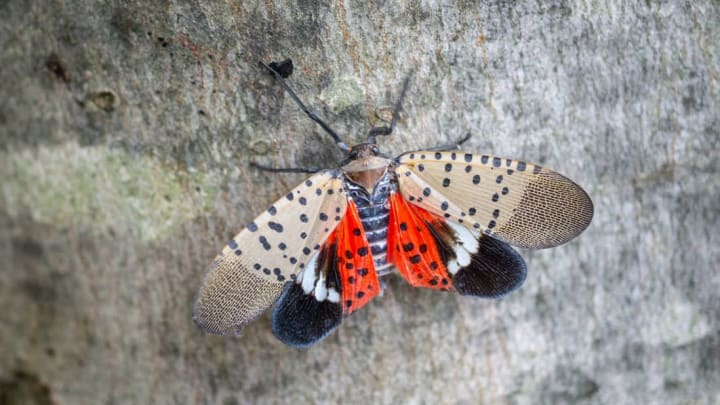Insects aren’t the biggest or most intimidating invasive animals, but they’re among the most destructive. Many invasive insect species ravage important trees and crops, adding up to billions of dollars in losses. Without natural predators, diseases, and other pressures from their native environments to keep them in check, their populations can explode to catastrophic numbers. They may be small, but these insects have caused serious damage since invading the U.S.
1. Spotted Lanternfly

A relative newcomer, the spotted lanternfly arrived in the U.S. from northern China in 2014. Since its discovery in Berks County, Pennsylvania, the insect species has spread to neighboring states in the mid-Atlantic. It’s known for its large, black-spotted gray wings and its destructive behavior. Spotted lanternflies eat sap from more than 70 different plant species, including important crops like grapevines, maple trees, and black walnut trees. Lanternflies can lay up to 200 egg masses on one host plant, and the bugs’ sugary secretions have been known to promote mold growth. According to the Pennsylvania Department of Agriculture, the insect could cost the state $324 million a year if it isn’t controlled.
2. Brown Marmorated Stink Bug

It may be hard to remember, but there was a time when the brown marmorated stink bug wasn’t part of North America’s ecosystem. The first specimens in the U.S. were collected in Allentown, Pennsylvania, in 1998, though they may have arrived a few years prior—possibly on a shipping container from their native home of East Asia. Stinkbugs have since spread across the country. In addition to their pungent spray, the insects are notorious for the threat they pose to agriculture. They’re known to eat at least 100 types of crops. It’s estimated that brown marmorated stink bugs caused $37 million in damages to mid-Atlantic apple crops in just the 2010 season.
3. Asian Citrus Psyllid

The spread of the Asian citrus psyllid has been disastrous for the citrus industry. The tiny insect from South Asia has been present in the U.S. since 1998, and today it can be found in 10 states including Florida and California. The Asian citrus psyllid feeds on fruit leaves and stems, but the greatest threat it poses is the spread of disease. The bugs can carry bacteria that causes Huanglongbing, or citrus greening disease. It's deadly to trees, and it’s already cost Florida’s agriculture industry billions in losses.
4. Emerald Ash Borer

They may look pretty, but emerald ash borers are considered a pest in many parts of North America. In their larval state, the bugs bore into ash trees and consume the inner bark. Hundreds of millions of trees on the continent have succumbed to the invasive species this way. A shipment of wood materials from China likely brought the insect to the U.S. in 2002. Today, they’re active in at least 30 states.
5. Formosan Termite

Originally from China, the Formosan termite has spread across the globe. It was first noticed in the continental United States in the 1960s, and it’s since established itself in the South. The insect species is notable for its massive colonies and destructive appetite. One population of Formosan termites contains up to several million specimens. At those numbers, the bugs are capable of inflicting serious damage to large wooden structures like houses.
6. Gypsy Moth

The arrival of the gypsy moth in North America can be traced back to an ill-conceived business scheme. By the late 1860s, disease had stricken traditional silk moth populations, and enterprising entomology enthusiasts were looking for new bugs to supplement them. Étienne Léopold Trouvelot of Medford, Massachusetts, was one of them, and in 1868 or 1869, he received a package of silk-producing insects from France. Some eggs inside the package belonged to the gypsy moth—an insect native to Eurasia. After Trouvelot cultivated them in his backyard, some moths escaped and reproduced in the wild. Little did he know that gypsy moth caterpillars feed on 300 species of trees and shrubs, often stripping them of their leaves and making them vulnerable to other pathogens. The moths are currently found in 20 states in the Midwest and on the East Coast.
7. Asian Long-Horned Beetle

Discovered in New York in 1996, this long-antennaed beetle originates from Korea and China. Today it inhabits parts of Massachusetts, New York, Ohio, and South Carolina. The larvae of the insects species threaten hardwood trees by boring into them and feeding on the living tissue. According to the USDA’s Animal and Plant Health Inspection Service, the Asian long-horned beetle is capable of doing more damage to trees than Dutch elm disease, chestnut blight, and gypsy moths combined.
